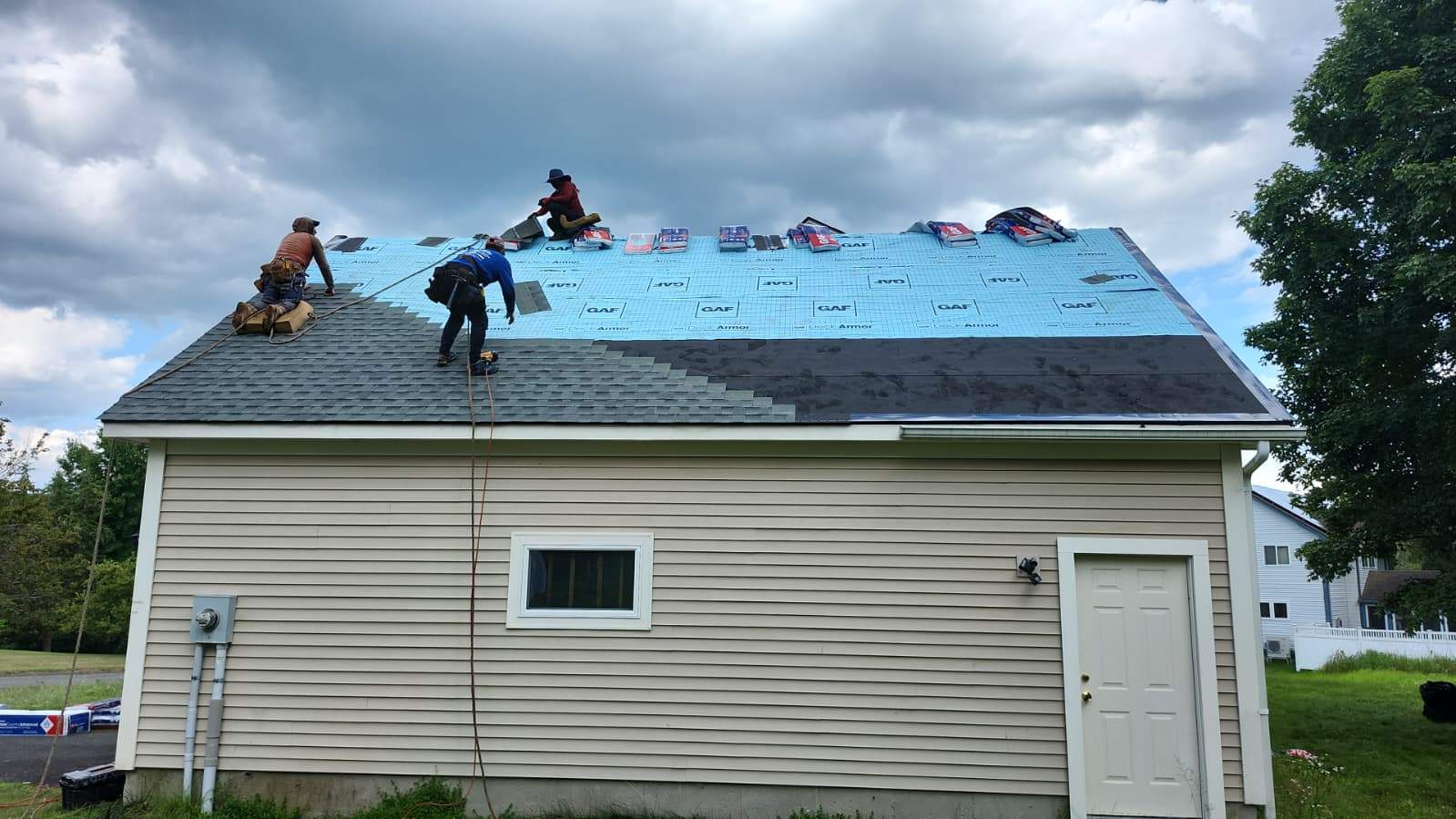
What Is a Slate Roof? Benefits, Costs & Lifespan Explained
When it comes to roofing materials, few can rival the timeless beauty, exceptional durability, and prestigious appeal of slate roofs. For centuries, slate has adorned the rooftops of grand estates, historic buildings, and upscale homes, renowned for its distinctive appearance and incredible longevity. If you're considering a roofing material that offers both premium aesthetics and a remarkably long lifespan, understanding what is a slate roof – from its natural origins to its installation complexities – is essential.
What defines a slate roof
A slate roof is a roofing system composed of individual pieces of natural stone, known as roofing slates. These slates are specifically cut from metamorphic rock, typically formed from shale or clay, that has undergone immense pressure and heat over millions of years. This geological process gives slate its defining characteristics:
Natural Stone Composition: Each slate tile is a piece of genuine rock, giving it an unparalleled natural beauty and variation in color and texture.
Exceptional Durability: Slate is incredibly dense and non-porous, making it highly resistant to water absorption, fire, hail, and extreme weather conditions. Unlike many other roofing materials, it won't rot, burn, or be easily damaged by impact.
Unique Aesthetics: No two slate tiles are exactly alike. They come in a range of natural colors including various shades of gray, green, purple, black, and even red, often with subtle marbling or veining. This natural variation creates a roof with immense character and curb appeal.
Incredible Lifespan: A properly installed slate roof can last anywhere from 75 to 200 years or more, often outliving the building it protects. This makes it one of the longest-lasting roofing materials available.
Splitability: A key characteristic of roofing slate is its ability to be split into thin, uniform tiles, perfect for roofing applications.
Natural vs. Synthetic slate options
While natural slate is the original and most prestigious option, advancements in manufacturing have introduced synthetic alternatives.
Natural Slate
Authenticity: Made from 100% natural quarried stone.
Appearance: Features natural color variations, unique textures, and a genuinely organic look that cannot be perfectly replicated. Colors are permanent and will not fade.
Lifespan: The longest-lasting roofing material, with lifespans often exceeding 100 years.
Weight: Very heavy, requiring significant structural support.
Cost: The most expensive roofing material, both for materials and specialized installation.
Environmental Impact: A natural, sustainable material, though quarrying processes vary in environmental friendliness.
Synthetic (Composite) Slate
Composition: Manufactured from various materials, commonly recycled rubber and plastics, or virgin polymers.
Appearance: Designed to mimic the look of natural slate, available in a wider range of consistent colors and sizes. Can be very convincing from a distance.
Lifespan: Typically 30-50 years, which is comparable to high-end asphalt shingles, but significantly less than natural slate.
Weight: Much lighter than natural slate, often making it suitable for existing roof structures without extensive reinforcement.
Cost: More affordable than natural slate, making it a viable option for those who desire the slate look without the premium price tag.
Environmental Impact: Often made from recycled materials, which can be an attractive eco-friendly feature.
Choosing between them often comes down to budget, desired lifespan, and whether the authenticity of natural stone is a top priority.
Structural considerations & weight load
One of the most significant factors when considering a slate roof is its substantial weight.
Heavy Material: Natural slate is exceptionally heavy, typically weighing between 8 to 15 pounds per square foot, and sometimes even more for thicker slates. This is significantly heavier than asphalt shingles (around 2-4 lbs/sq ft) or even concrete tiles.
Structural Reinforcement: Due to this immense weight, the underlying roof structure and often the entire building's framing must be robust enough to support the load.
New Construction: Architects and engineers can design the structure to accommodate the weight from the outset.
Existing Homes: An older home built for a lighter roof might require extensive and costly structural reinforcement (e.g., adding rafters, stronger trusses, or additional wall supports) before a natural slate roof can be installed.
Professional Assessment is Crucial: Before deciding on a natural slate roof, it is absolutely essential to have a qualified structural engineer and an experienced roofing contractor assess your home's existing framework. This assessment will determine if reinforcement is needed and provide an accurate estimate of the associated costs and complexities.
Installation challenges & timeline
Installing a slate roof is a highly specialized craft that demands skilled expertise and a significant investment of time.
Specialized Skill Set: Unlike other roofing materials, slate cannot be installed by just any roofer. It requires highly trained and experienced slate roofing specialists who understand the unique techniques for cutting, trimming, punching holes, and laying individual slate tiles. Improper installation can lead to premature failure and costly repairs.
Fragility During Installation: While durable once installed, individual slate tiles can be fragile and prone to breaking during handling and installation. This necessitates careful work and a higher material waste factor.
Unique Fasteners: Slate tiles are typically installed with two non-corroding nails (copper or stainless steel) per tile, strategically placed to allow for slight movement and to prevent the nails from being exposed to the elements.
Underlayment: A high-quality, often self-adhering, ice-and-water shield or a durable felt underlayment is critical beneath slate to provide an extra layer of waterproofing and protection.
Longer Timeline: Due to the precision required, the individual handling of each tile, and the specialized techniques, a slate roof installation takes considerably longer than installing other roofing materials. The timeline can stretch from several weeks to months, depending on the roof's size and complexity.
Cost of Installation: The specialized labor and extended timeline make slate roof installation significantly more expensive than other roofing options.
Maintenance tips and warranty expectations
While slate roofs are renowned for their longevity, proper maintenance is still key to maximizing their lifespan and protecting your investment.
Maintenance:
Regular Inspections: Periodically (e.g., annually) have a qualified slate roofing professional inspect your roof for any slipped, cracked, or broken slates. These should be addressed promptly to prevent water infiltration.
Gutter Cleaning: Keep gutters and downspouts clear of debris to ensure proper drainage and prevent water buildup, which can lead to ice dams and damage.
Snow Removal (Caution): While slate can handle heavy snow, avoid walking on a snow-covered slate roof, as tiles can be very slippery and prone to breaking.
Avoid Walking on Roof: Only experienced slate roofers should walk on a slate roof, using specialized ladders or crawling boards to distribute weight and prevent damage to the brittle tiles.
Moss and Lichen: While not typically damaging to the slate itself, excessive moss or lichen can retain moisture. A professional can advise on safe removal methods if desired, avoiding harsh chemicals or pressure washing.
Warranty Expectations:
Material Warranty: Natural slate typically comes with very long-term material warranties, often 50 years to the lifetime of the original homeowner, reflecting its inherent durability. Synthetic slate warranties are usually 30-50 years.
Workmanship Warranty: The workmanship warranty from your installer is crucial. Given the complexity of slate installation, a reputable contractor will offer a substantial warranty (e.g., 5-10 years or more) on their labor, guaranteeing that the roof is installed correctly.
Transferability: Inquire if the material or workmanship warranty is transferable to a new homeowner, which can be a significant selling point for your home.
A slate roof is a premium investment, offering unparalleled beauty, durability, and a lifespan that can span generations. While it requires a substantial upfront cost and specialized installation, its long-term value, minimal replacement needs, and timeless appeal make it a highly desirable choice for discerning homeowners. If you're considering a slate roof for your home, partnering with an experienced and reputable roofing contractor is essential. Masterpiece Roofing specializes in the expert installation and meticulous care of slate roofs, ensuring your investment is protected by true craftsmanship.
Considering the lasting beauty and protection of a slate roof? Contact Masterpiece Roofing today for a comprehensive consultation and a detailed estimate
Office: 1248 Highland St, Holliston, 01746 MA
(508) 882-6080
Email: office@buttonmasterpieceroof.com
Site: www.masterpieceroof.com
Assistance Hours
Mon – Fri 8:00am – 4:00pm

